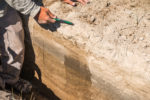 A team of scientists have unearthed a Pleistocene-era Columbian mammoth trackway at Fossil Lake, Oregon. The fossilized footprints are about 43,000 years old and include tracks left in the volcanic soil by adult, juvenile and infant mammoths. There are 117 footprints, a large enough number and wide enough range of ages that studying the track will lend new insight into how mammoths interacted with each other as a herd.
A team of scientists have unearthed a Pleistocene-era Columbian mammoth trackway at Fossil Lake, Oregon. The fossilized footprints are about 43,000 years old and include tracks left in the volcanic soil by adult, juvenile and infant mammoths. There are 117 footprints, a large enough number and wide enough range of ages that studying the track will lend new insight into how mammoths interacted with each other as a herd.
The first footprints were discovered in 2014 by paleontologist Greg Retallack of the University of Oregon’s Museum of Natural and Cultural History during a field trip with UO students to study fossil plants. The site is administered by the Bureau of Land Management, so last year BLM researchers partnered with researchers from the University of Oregon (including Retallack) and University of Louisiana researchers to explore the trackway.
Initially, the UO-led team, which included Adrian Broz, now a doctoral student of Retallack’s who had been in the fossil class, quickly zeroed in on a 20-footprint track exhibiting some intriguing features.
“These prints were especially close together, and those on the right were more deeply impressed than those on the left — as if an adult mammoth had been limping,” said Retallack, who also is a professor in the Department of Earth Sciences.
The limping animal wasn’t alone, the six-member research team reported in a study published online ahead of print in the journal Palaeogeography, Palaeoclimatology, Palaeoecology. Two sets of smaller footprints appeared to be approaching and retreating from the limper’s trackway.
“These juveniles may have been interacting with a limping adult female, returning to her repeatedly throughout the journey, possibly out of concern for her slow progress,” said Retallack, the study’s lead author. “Such behavior has been observed with wounded adults in modern, matriarchal herds of African elephants.”
Trace fossils such as those found in trackways can provide unique insights into natural history, Retallack said.
“Tracks sometimes tell more about ancient creatures than their bones, particularly when it comes to their behavior,” he said. “It’s amazing to see this kind of interaction preserved in the fossil record.”
 The team also studied the soil layers at the trackway site. It appears the climate and plants in the Fossil Lakes area in the Ice Age were not dissimilar to its modern counterpart, although the lakes were larger, it was drier in the summer and precipitation was higher in the winter. There was also more lowland grassland, one of the Columbian mammoth’s preferred foods. The mammoths and other grass-eaters (a prehistoric horse print was also found at the trackway) were essential to the grassland ecosystem. They fertilized it with their dung and suppressed other plants by trampling and uprooting them during grazing. It’s likely that the fertile grassland of the Ice Age succumbed to desertification after the extinction of the mammoths and other large native grass-eaters 11,500 years ago. Hence the dry lake beds and their precious cargo of fossils.
The team also studied the soil layers at the trackway site. It appears the climate and plants in the Fossil Lakes area in the Ice Age were not dissimilar to its modern counterpart, although the lakes were larger, it was drier in the summer and precipitation was higher in the winter. There was also more lowland grassland, one of the Columbian mammoth’s preferred foods. The mammoths and other grass-eaters (a prehistoric horse print was also found at the trackway) were essential to the grassland ecosystem. They fertilized it with their dung and suppressed other plants by trampling and uprooting them during grazing. It’s likely that the fertile grassland of the Ice Age succumbed to desertification after the extinction of the mammoths and other large native grass-eaters 11,500 years ago. Hence the dry lake beds and their precious cargo of fossils.
There are some killer drone’s eye views of the trackway and the wild dessert beauty of the Fossil Lake area in this video:
The study, still in the corrected proof stage, is available for purchase here.
qyite worthy and serious information.
Thank you so much for letting us know about this.
I will be here to check more posts like this.
Oregon is imminently to be destroyed, you know, by the Cascadia subduction. Around the third Tuesday in April, then.
Must be true. Science, innit?
Your point, dearieme? You seem to be ironic about something, but to what end is a mystery.
Gorgeous! Imagine being that teacher, looking for fossil plants and finding mammoth tracks instead. :boogie:
I am endlessly impressed by how much information scientists of all stripes can extract from snippets of data like this.
Karen- You have said exactly what I wanted to say. Great experience for teacher and students. I am always amazed at all the finds and artifacts still being found every day! ( just about)
Was I really the only one, who wondered how on earth mammoths from Columbia(!) had managed to break through onto the other side, and in which way their footprints differed from American standard mammoths?
As it then turned out, back then the barrier had actually been the ice shield to Canada, and ‘Columbian’ only means ‘Not Woolly’.
Our limping Pleistocenic Pachyderme was either suffering from old age and a hip arthritis, or it might have had an interference with a predator, or it had to ward a predator off.
———–
P.S.: Oregon -if I saw that correctly- is actually ‘surfing’ onto the said subduction zone. Like anything else, therefore, it might break apart, but it will certainly take its time and Canada will probably come up first. – May be April